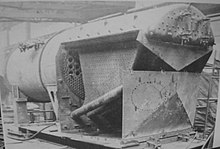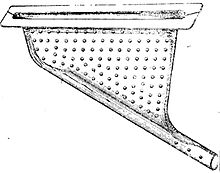Thermosiphon (steam boiler)
The thermosiphon , also known as a water chamber or water pocket , is a heat exchanger element in the fire box of steam locomotive boilers or in the flame tube of large-volume steam boilers , with several elements usually being built into a system. The thermosiphon is directly exposed to the radiant heat from the combustion, so it has a high evaporation capacity in relation to its size. The almost vertical arrangement results in good water circulation in the boiler thanks to the thermosiphon effect. The heated water rises in the thermosiphon and draws cold water into the heat exchanger element.
history
Stationary systems
The concept of a steam boiler with water circulation using the thermosiphon effect began with stationary shell boilers. In the flame tube, vertical or inclined tubes were installed for the first time in the 1840s, which allow the heated lower boiler water to rise to the upper boiler water and at the same time expose it to the heat of the flue gases and thereby allow it to be heated even further. A second function of these tubes was to stiffen the flame tube in the boiler.
This first form of the thermosyphon was refined by the company W & J Galloway & Sons and a patent was applied for in 1849. It made the tubes conical so that they could be more easily inserted into the flame tube during assembly. This design prevailed for stationary systems and is called Galloway tubes after the inventor .

Steam locomotive boiler
Particularly light and space-saving boilers had to be designed for locomotives. Nevertheless, the highest possible evaporation capacity should be achieved. For this purpose the English engineer John L. Nicholson developed the Nicholson thermosyphon named after him. The patent was filed in 1918 and exploited by the Locomotive Firebox Co. in Chicago , later also by Beyer-Peacock . The first locomotives equipped with this new development were used on Milwaukee Road . Comparative tests have shown that a locomotive equipped with thermosyphons saves up to 25% coal compared to one without these heat exchanger elements.
Web links
- Tom Morrison: The American Steam Locomotive in the Twentieth Century . McFarland, 2018, ISBN 978-1-4766-6582-5 , 7.2.5 Thermic Siphons, p. 217-218 (English, google.com ).

